Portland planner and longtime Historic Landmarks Commission member Leo Dean Williams is being honored with the seventh annual George McMath Historic Preservation Award. For nearly thirty years, Williams, an urban design architect, was an essential member of a team of civic leaders who created, expanded, and implemented Portland’s historic preservation program. He is also credited for reinstituting urban rail in Portland.
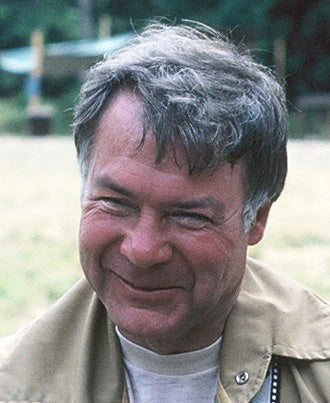
Above: Leo Dean Williams about 1985.
The award will be formally presented Wednesday, May 13, during an awards luncheon from 11:30 a.m.-1:00 p.m. at the UO in Portland. Tickets to the award luncheon may be purchased online.
“Mr. Williams’s efforts in promoting preservation in the wider community … contributed significantly to Portland’s success,” says Elisabeth Walton Potter, an architectural historian and recipient of the McMath award in 2011. Williams is among the “pioneering leaders [who] made Portland the crucible of Oregon’s early preservation movement,” Potter notes.
Williams arrived in Portland at a favorable time for the city and its future in historic preservation. State and local governments were only beginning to gear up to administer provisions of the National Historic Preservation Act of 1966. The City of Portland, encouraged by Portland Chapter AIA member George McMath, had adopted a landmark preservation ordinance in 1968, only the second such municipal ordinance on the West Coast after that of Los Angeles. He also helped create the Urban Conservation Fund, which assisted in restoring many of Portland’s iconic landmarks such as the New Market Theater.
Williams was “the indispensable figure in the Portland Bureau of Planning in that era when historic preservation was yet an emerging movement,” Potter says. Attuned to the value of historic buildings and cohesive older neighborhoods, he was at the forefront of the preservation movement with McMath, who chaired the city’s landmarks commission for a decade. Together, they implemented the City’s landmark preservation ordinance and championed the state’s model 1975 property tax abatement program for buildings listed on the National Register.
“Leo’s leadership in defining and protecting landmark and conservation districts enhanced the city’s livability,” Potter says.
Williams’ efforts to establish the landmarks commission “was terribly important, especially since there was significant demolition going on at the same time,” notes William J. Hawkins, III, the 2013 McMath Award recipient. “Leo witnessed and pursued the change in the city’s then-extant ‘demolition culture,’ when important buildings were, it seemed, coming down every day, to [ensure] the preservation and incorporation of important works of historic architecture in the city’s growth and development. It was a monumental turn around, and Leo played a significant role,” Hawkins says.
Notes John Southgate, a Portland metro area planner and economic development director, Williams “possesses a keen design sense from which the historic preservation movement and the larger urban design culture of Portland benefitted enormously. He forged critical partnerships with the private sector, as well as Portland's elected leaders, establishing an ethic of collaboration and cooperation toward the shared goal of restoring Portland's architectural treasures.”
Williams accomplished that through both overseeing legislative framework as well as “the important spade-work of designating individual landmarks and subsequently Portland’s first four designated [historic] districts,” Southgate says.
“There are buildings standing today—legacies from our past— that would not be standing, let alone restored, if not for Leo's leadership and his marvelous capacity to work with elected officials, property owners, community leaders, and others,” Southgate says. “Governor Tom McCall once said, ‘Heroes are not giant statues framed against a red sky. They are people who say: This is my community, and it is my responsibility to make it better.’ Leo has truly made his home, his Portland, a better place by far.”
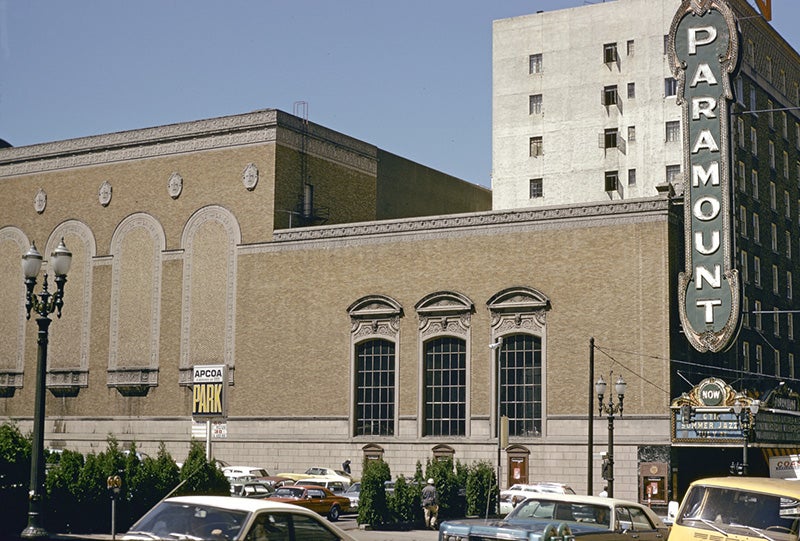
Above: This 1974 view of the Arlene Schnitzer Concert Hall, which opened in 1928 as the Portland Publix Theater before becoming the Paramount Theatre. This perspective shows how the New Theater was blended within the historic context of the original theater. This is the last surviving theater building on Broadway in Portland, which was once lined with large theater houses. Photo by Marion Dean Ross. Gift of Wallace K. Huntington from the estate of Marion Dean Ross. Photo courtesy UO Libraries Digital Collections.
One of Williams’ key skills was “the gentle art of persuasion, meeting with property owners and elected officials to help illuminate them to the value of the landmark whose fate they controlled,” Southgate notes. But Williams didn’t restrict his gentle tutelage to adults. He also became known for a three-screen, multi-image presentation on Portland’s heritage that he presented at various venues, notably to schoolchildren. He created the twenty-minute, four-part presentation, which he called an “image essay,” in 1974.
Entitled “How Do We Know It is Us Without Our Past?” the show was a mixture of “ ‘tongue in cheek’ seriousness, hokeyness, and humor,” Williams wrote in a flyer describing the presentation. Using three screens was revolutionary at the time, enabling him to show textual information in the middle framed by photographs from the past on one side and current photos of the same landmark on the opposite screen. It employed music that matched the era of the architecture: Jazz for Art Deco, Scott Joplin for early 20th Century, early rock ‘n’ roll for more modern landmarks such as Belluschi’s Equitable Building.
The show served as a first introduction, to many viewers, of the concept of historic preservation and why it is important. The show’s “finale” summarized how
…preservation is only one of the threads in our urban design fabric, but like ‘rip-stop nylon’ it is one of the guardian threads. Portland is a complicated and diverse collection of many qualities. The people of Portland have an encompassing subscription to quality, and they care for the city! This has made the difference in being able to deliver the urban design products that we enjoy and share as a community. For the citizens, this city is a love affair!
“As important as Leo’s efforts were in designating and protecting hundreds of historic buildings in Portland,” Southgate contends, “Leo would certainly consider his program for youth his greatest legacy—awakening in children an appreciation for our past, for what makes cities livable.”

Above: Williams in 2015
Williams also played a key role in the evolution of Portland’s transportation planning into the globally recognized model it is today. In the 1970s he was part of “a small group of downtown revivalists” hoping to stem the migration of businesses from downtown Portland to suburban shopping centers. “The idea was to bring back historic trolleys resembling their century—old forbears, creating fun while adding unique attraction value to Portland’s downtown, much the way cable cars contribute to San Francisco’s colorful cityscape,” says William L. Failing, Jr., past president of the Oregon Historical Society, president of Vintage Trolley Inc., and founding board member of Oregon Architectural Center and Portland Streetcar Board.
The trolley idea caught Williams’ attention as a city planner, prompting him to form the Trolley Line Steering Committee. “The conversation soon morphed beyond vintage streetcars, shaping a whole new rail vision for the City,” Failing says. “This became the catalyst and momentum-driver to give birth to rail transit as we know it today. Most of us who served on this committee consider this the inception of modern rail transportation in Portland, eventually extending to other urban areas in the country, embracing rail transit to address urban growth issues,” Failing says.
Williams was ahead of his time in general, regarding preservation in Portland.
“Leo Dean Williams epitomizes the early adopter who witnessed, firsthand, the routine demolitions of the incredible architectural heritage in Portland and took action,” notes Chris Bell, interim director of the Historic Preservation Program at UO. “Through his role at the City of Portland in urban planning, he oversaw a great range of critical actions—from instituting regulatory frameworks that simultaneously reduced demolition while promoting and funding recordation and adapative reuse, to building a new cohort of preservation advocates starting at the Portland public schools through a wildly popular traveling show about what the past matters. The committee felt strongly about honoring Leo's legacy, and how the city planning process plays a crucial role in the fate of Oregon's historic fabric.”
The McMath award is presented each year to an individual whose contributions have raised awareness and advocacy for historic preservation in Oregon.
The award ceremony this year will include a presentation by historic preservation graduate student Josette Katcha, speaking on "Save or Scrap: Deconstructing the Impact of Architectural Salvage on Historic Preservation."
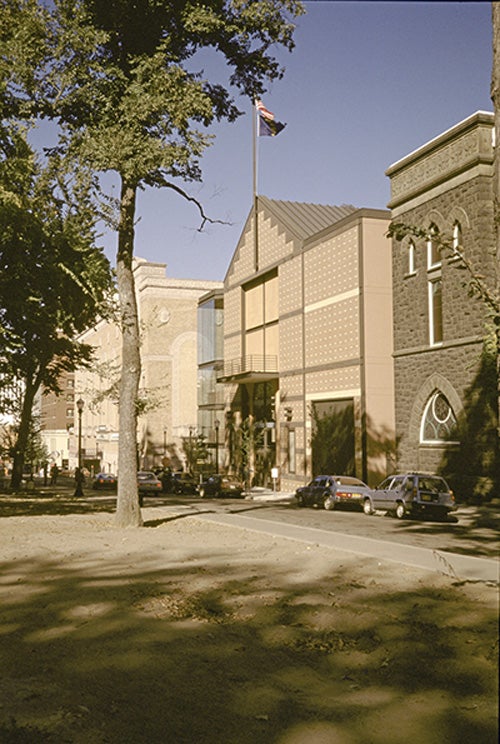
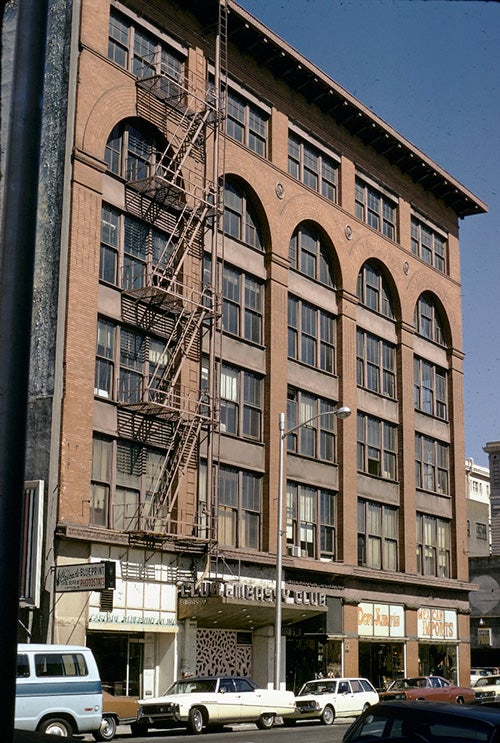
Above left: Antoinette Hatfield Hall, formerly known as the New Theatre Building, in 1987. It is sometimes referred to as the New Theater or the Portland Center for the Performing Arts. Photo by Marion Dean Ross. Gift of Wallace K. Huntington from the estate of Marion Dean Ross. Photo courtesy UO Libraries Digital Collections. Above right: The 1894 Sherlock Building as it appeared in 1974. Currently occupied by the Church of Scientology, it is the only structure in Oregon apparently influenced by the work of Louis Sullivan. The Richardsonian Romanesque building was almost lost to the wrecker’s ball but Williams urged the City Council to protect it from demolition, buying the building breathing space so that a new owner could come along and save it. Photo by Marion Dean Ross. Gift of Wallace K. Huntington from the estate of Marion Dean Ross. Photo courtesy UO Libraries Digital Collections.
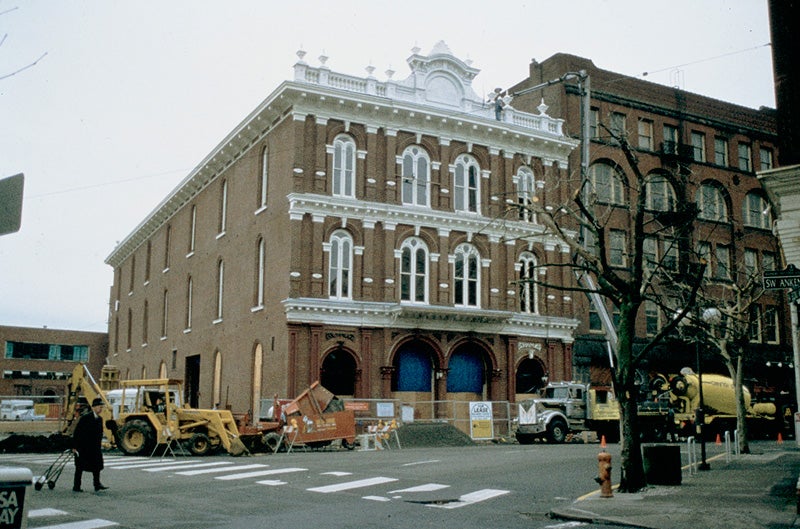
Above: The left and front facades of the 1872 New Market Theater as restoration was wrapping up in 1983. The restoration was by SERA, Allen, McMath, and Hawkins. Photo from Oregon State Historic Preservation Office, courtesy UO Libraries Digital Collections.
